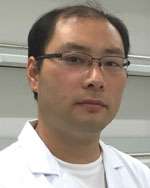Cell therapy is a promising approach in treating central nervous system (CNS) disorders. This is suggested by the findingof clinical benefits in some Parkinson's disease (PD) patients who received striatal transplantation of human fetal mesencephalic tissues. Human pluripotent cells (hPSCs) including human embryonic stem cells (hESCs) or induced pluripotent stem cells (iPSCs) substantially expand prospect of cell therapy. By differentiation into functional neurons, hPSCs provide unlimited source for cells. Following transplantation into model animals, hPSC-derived neuronal cells contribute to behavioral recovery in model animals of Huntington disease (HD), spinal cord injury, Parkinson's disease (PD), and epilepsy. These results highlight the potential of hPSCs in treating debilitating diseases like neurodegenerative disorders. Our lab is interested in dissecting the mechanisms of cell therapy in the adult brain and developing novel strategies of cell therapy for neurodegenerative disorders including PD.
Current Interests
1. The mechanisms of cell therapy in the adult brain
For cell therapy to succeed in neurological disorders, the grafted neuronal progenitor cells should survive and differentiate into specific types of neurons, which then send out axons and navigated in the mature CNS environment to find their target brain region. Finally, these neurons should make functional synaptic connections with their designated neurons and receive proper innervations, thus functionally replacing the lost or degenerated host neurons. The specific neuronal projection and connections in the adult brain are formed during development by complex mechanisms including multiple chemotropic guidance cues, extracellular matrix-cell interaction, cell-cell interaction, guidance of radial glial cells. However, most of these axonal guidance mechanisms diminished in the adult brain, and only a portion of guidance cues could be detected in a few defined regions at reduced level. The specificity and mechanisms of neuronal connection of grafted cells in adult host brain are largely unknown. Through the use of a synthesis of directed differentiation of stem cells, CRISPR/Cas9-mediated genome editing, cell transplantation, histology analysis, virus mediated retrograde and anterograde transsynaptic tracing and functional magnetic resonance image (fMRI), we attempt to understand the fundamental principles of axonal projection and neuronal connection of grafted neurons in the adult brain.
2. Developing novel strategies for cell therapy in PD
In PD cell therapy, the differentiation efficiency of human midbrain dopamine (mDA) neuron in the animal brain is generally low (rang from 5% to 60%). The resulting grafted cells are often mixed population of neuronal cells including mDA neurons, GABA neurons, serotonin neurons, astrocytes and other uncharacterized cells. At least two subtypes of mDA neurons, substantianigra compact (SNc) DA neurons and ventral tegmental area (VTA) DA neurons, are present in the human grafts. It has been reported that serotonin neurons in the human graft derived from human fetal mesencephalic tissues will cause graft-induced dyskinesia (GID), the most severe side effect in PD cell therapy. It is also still debated whether VTA-DA neurons in the graft contribute to the motor functional recovery of PD model animals or cause side effects as VTA neurons can widely regulate the natural reward circuitry of the brain. In most studies, the therapeutic effect of cell therapy is evaluated from xenograft of human cells in PD animals with normal brain environment. It is unknown whether similar therapeutic effects could be obtained in aged and/or diseased brain environment under homograft condition. By using CRISPR/Cas9-meditaed genome editing, multiple factors-confined reporter system, virus expression system, eletrophysiology, and directed neural differentiation, we attempt to develop novel mDA subtype specific differentiation method and determine the therapeutic effect of grafted cells in rodent brain under xenograft condition and aged non-human primate brain under homograft condition. We are also interested in developing novel PD non-human primate model to mimic the diseased host brain environment for cell therapy.
The long-term goal of our group is to develop safe and effective strategies for clinical application of cell therapy in neurodegenerative disorders.

Senior Investigator